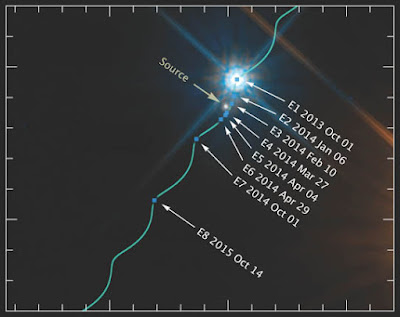 |
| Image Source: Link below |
Topics: Astronomy, Astrophysics, Einstein, General Relativity, Gravitational Lensing, White Dwarfs
The passage of a white dwarf almost in front of a distant background star created the conditions for gravitational lensing
Einstein’s general theory of relativity predicts that in the gravitational field of a massive body, light rays should bend by an angle that depends on the body’s mass. Researchers at the Space Telescope Science Institute have now exploited that effect, known as gravitational lensing, to determine the mass of a star. For two years, the team tracked white dwarf Stein 2051 B as it crossed in front of a distant background star. The Hubble image shows Stein 2051 B and the background star, labeled “Source,” on 1 October 2013. Overlain are the nearer star’s trajectory and dots indicating its location on seven subsequent imaging dates. (The trajectory appears curved due to parallax.) At their closest, the stars were separated by a mere 10th of an arcsecond—roughly the angle subtended in the sky by Pluto.
As the stars came into alignment, gravitational lensing by the white dwarf subtly distorted the apparent position of the background star. Specifically, the background star appeared to trace an ellipse a couple of milliarcseconds wide, even though its actual position in the sky all but remained fixed. From the ellipse’s dimensions the researchers could infer Stein 2051 B’s mass, roughly two-thirds that of the Sun.
Comments